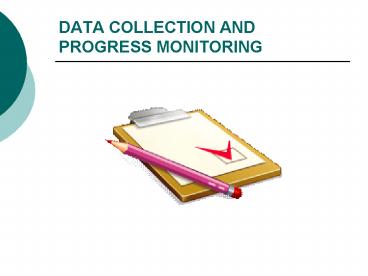DATA COLLECTION AND PROGRESS MONITORING - PowerPoint PPT Presentation
1 / 26
Title:
DATA COLLECTION AND PROGRESS MONITORING
Description:
Observer: ESE Director. Latency Data Recording Sheet ... write down everything the student does or says, like a court reporter ... – PowerPoint PPT presentation
Number of Views:201
Avg rating:3.0/5.0
Title: DATA COLLECTION AND PROGRESS MONITORING
1
DATA COLLECTION AND PROGRESS MONITORING
2
What is Data Collection?
- Data Collection is an on-going process that
provides a permanent record of student learning
and the acquisition of new skills.
3
Why use Data Collection?
- Vital component of a legally defensible special
education program - Focus on accountability for programs and school
personnel - Teacher observation and anecdotal notes are no
longer enough - Collection/display of data make the progress
visible for students who make small amounts of
progress - Tools provide information to school personnel and
parents on the gains made by the students - Analysis of data provides information regarding
the effectiveness of the instruction and program
4
Where do we start..
- Good Teaching is
- Good Teaching
5
Instruction Differs From Student to Student
- Mild Mental Disabilities
- Access to the general education curriculum
- SC Curriculum Standards
- Significant accommodations and modifications
- Modeling Show and tell
- Pencil/Paper tasks
- Classroom-based Instruction
- Considered normal
- Moderate to Severe Mental Disabilities
- SC Alt. Assessment Standards and Measurement
Guidelines (ASMGs) - Functional Curriculum
- Use of concrete materials and objects
- Performance-based activities
- Community-based Instruction
- Normalization
6
Service Delivery System
- How to teach
- What to teach
- Where to teach
7
Objectives Should Be Defined Specifically!
- In order to implement data-based instruction,
we must be clear about WHAT were going to teach
and HOW its going to be evaluated.
8
Systematic Instruction
- Well- Specified
- Outcome
- Begin with the end in mind!
9
Systematic Instruction and data collection
- Collect Information About Student
- Performance To Revise
- Or Alter The Game Plan
- Higher Functioning Studentstests, projects, MAP
scores, data collection - Lower Functioning Studentsdata collection
10
Resources for Data Collection and Progress
Monitoring
- ESE Website Resources
- Rock Hill District Three
- -Departments
- -Exceptional Education Services
- -Data Collection Tools
11
Guidelines for Data Collection
- Forms included in student profile - information
used for PLAFP - Data collection area established in classroom for
easy access - All staff responsible for data collection
- Analyze data regularly to guide instruction
- Specific mastery criteria and measurable outcomes
- Individualized for each student
- Collection methods implemented across various
times and settings during the school day
12
KISS
- Specific data collection methods do not have to
be complicated or cumbersome. - Keep it short and simple!
13
Observational Data Collection(Kid Watching!)
- Task Analysis
- Duration
- Latency
- Frequency/Rate
- Timed-Interval
- Anecdotal/Narrative
14
Task AnalysisWhat are the Steps?
- Task Analysis breaking a task into the steps or
parts for teaching or checking student
performance.
15
Task Analysis for Walking to Class
16
Duration RecordingHow Long?
- Duration recording record how long a behavior
lasts
17
Duration Recording
Student Name Susan Conrad Target Behavior will
increase time on task to 15 minutes when checking
IEPs for compliance in 4 out of 5 work
sessions. Observer ESE Director
18
Latency Data Recording Sheet
- Latency recording How long it takes the student
to respond to a request. Count the time between
the request and when the student complies with
the request.
19
Frequency RecordingHow Often?
- Frequency Recording
- Record or tally the number of times the behavior
occurs
20
Frequency/Rate Recording
Student Susan Conrad Target Behavior will
decrease the number of times she overheats the
copy machine when preparing presentation
materials for 4 out of 5 teachers
meetings. Observer Aggravated ESE Office Staff
21
Timed Interval RecordingMinute to Minute?
- timed interval recording - at set time intervals
(i.e., each 10 seconds, each 30 seconds, each
minute), look at the student and record the
behavior you see. - Do this until you have at least 30 items
recorded.
22
Timed Interval Recording
- timed interval recording - set time intervals
(i.e., each 10 seconds, each 30 seconds, each
minute),
23
Timed Interval Recording
- timed interval recording - set time intervals
(i.e., each 10 seconds, each 30 seconds, each
minute),
24
Anecdotal or NarrativeAs it happens!
- Anecdotal or narrative recording - write down
everything the student does or says, like a court
reporter
25
We can no longerjust train and hope for the best!
- Teach the same old way and pray that the
student gets it.
26
IDEIA Instruction, Progress Monitoring, and Data
Collection What is required?
- 1. Define it
- Functional Performance
- Academic Achievement
- 2. Measure it
- Multiple Data Collection Methods
- 3. Use it
- Measurable Goals and Objectives
- Individual Student Progress
- Data driven decisions































